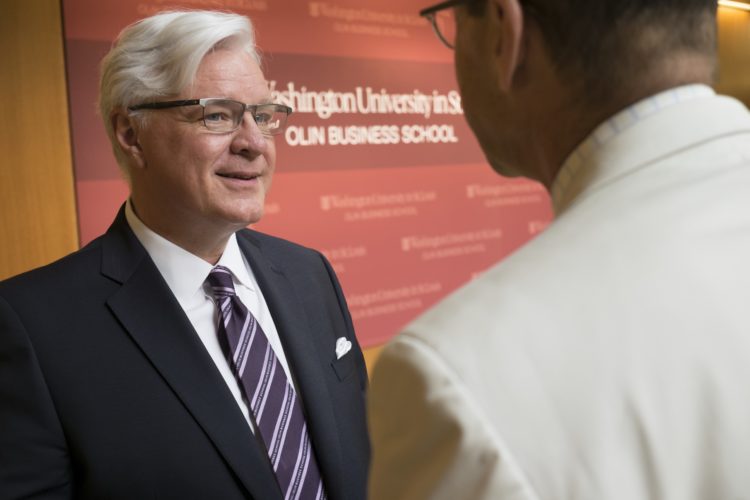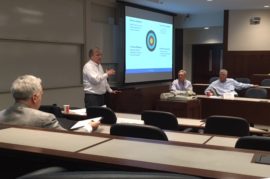After a whirlwind week in New York, we headed south to Washington, D.C. to immerse ourselves in the workings of government and financial regulation with Olin’s Brookings Executive Education (BEE) team as our guide. The day started with welcoming remarks and introductions from Ian Dubin, Associate Director, and Chris Mancini, Program Coordinator. They explained the general agenda for the week, and the long and special history between the Brookings Institution and Washington University in St. Louis.
 After the brief introduction, Mr. Dubin gave us an overview about the basic structures of U.S. government and legislative processes to set the stage for the week. He explained the unique roles of the Executive Branch, Senate and House of Representatives, and the complexity of the legislative process.
After the brief introduction, Mr. Dubin gave us an overview about the basic structures of U.S. government and legislative processes to set the stage for the week. He explained the unique roles of the Executive Branch, Senate and House of Representatives, and the complexity of the legislative process.
We also learned about the Brookings think tank and how it contributes to making public policy. The Brookings Institution is one of the most important and influential public policy research think tanks in the world.
The rest of the day was spent learning more about the various key financial sector regulators as well as learning directly from current and former regulators from both the Department of the Treasury and the Federal Reserve.
First, we learned from David Wessel, who is the Director of the Hutchins Center on Fiscal and Monetary Policy. He briefly explained the function of the United States Financial Stability Oversight Council (FSOC), and also introduced 10 micro-prudential regulators in the system, such as the Federal Deposit Insurance Corporation (FDIC), Securities and Exchange Commission (SEC), and The Federal Reserve, to name a few. Although the FSOC provided the chairperson of each of the 10 agencies with the opportunity to communicate with each other, he stated that those 10 chairs have different missions and have issued regulations on financial institutions (banks) that are conflicting. This resulted in banks having a hard time fulfilling the requirements outlined by different regulators. He also touched upon the importance of Macro-Prudential Regulation (FSOC role), and highlighted the differences between finance and other industries, especially in terms of contagion risk. Last but not the least, he compared the FSOC structure with that of the Bank of England.

Winthrop Hambley speaks to Olin students during their visit with Brookings Executive Education.
Our last speaker of the day was Winthrop Hambley, former Senior Advisor, Board of Governors, The Federal Reserve. He first introduced the structure of the Federal Reserve and its key monetary policy-making body, the Federal Open Market Committee (FOMC).
He then proceeded to explain to us both traditional monetary policies as well as non-traditional monetary policies, which were introduced after the financial crisis–namely, large scale asset purchases, forward guidance, and maturity extension.
Last but not least, to address the popular topic of the Fed rate hike expectation, he spent some time explaining to us the rate normalization process and considerations during Q&A.
This is part of a series of blogs chronicling the experiences of 41 Global Master of Finance (GMF) dual degree students during their two week long immersion course in New York and Washington, DC. Each blog will be written by a small subset of students during their experience.




 “I knew I wanted to go to business school when …” My department had a presentation from the executive leadership of the hospital on the changing face of medicine and the financial impact that new health care legislation would have on the delivery of health care. I knew that I wanted to get involved in this realm, trying to maximize the quality of health care for our patients in a fiscally responsible manner, something that an MBA would help me achieve.
“I knew I wanted to go to business school when …” My department had a presentation from the executive leadership of the hospital on the changing face of medicine and the financial impact that new health care legislation would have on the delivery of health care. I knew that I wanted to get involved in this realm, trying to maximize the quality of health care for our patients in a fiscally responsible manner, something that an MBA would help me achieve.

 After the brief introduction, Mr. Dubin gave us an overview about the basic structures of U.S. government and legislative processes to set the stage for the week. He explained the unique roles of the Executive Branch, Senate and House of Representatives, and the complexity of the legislative process.
After the brief introduction, Mr. Dubin gave us an overview about the basic structures of U.S. government and legislative processes to set the stage for the week. He explained the unique roles of the Executive Branch, Senate and House of Representatives, and the complexity of the legislative process.



 All three alumni shared their insights on how to prepare for the future.
All three alumni shared their insights on how to prepare for the future. Afterward, John Herber, Chairman, Rubin Brown, who was in attendance, said it was great to get this group together to engage in this kind of dialogue. It is so important, he said, that we think about costs and its impact related to IT needs in the future.
Afterward, John Herber, Chairman, Rubin Brown, who was in attendance, said it was great to get this group together to engage in this kind of dialogue. It is so important, he said, that we think about costs and its impact related to IT needs in the future.